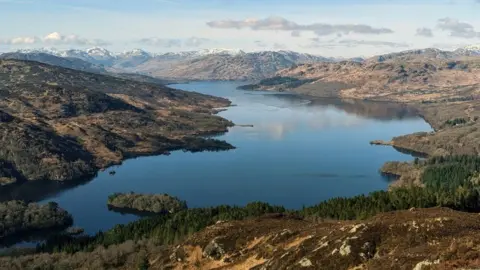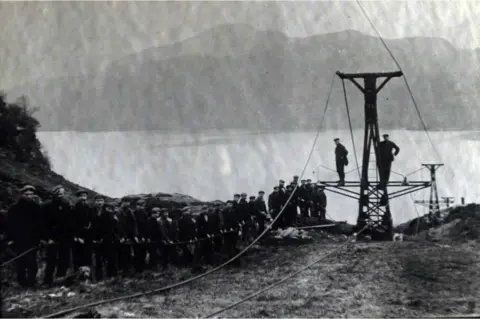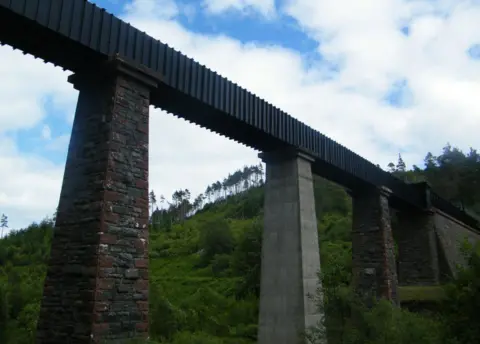Rewilding at Loch Katrine to secure water supplies as climate changes
 BBC
BBCPlans to restore the landscape around one of Scotland's most famous lochs to help deal with climate change have been approved.
More than 4,600 hectares around Loch Katrine is to have native forests, peatland and moorland restored over the the coming years.
The project, which will create one of Europe's largest new woodlands, is expected to capture a million tonnes of carbon over 60 years and help secure water supplies for a quarter of Scotland's population.
The proposals, from owner Scottish Water and tenant Forestry and Land Scotland (FLS), have been agreed by government agency Scottish Forestry.
Mark Williams, Scottish Water’s head of sustainability and climate change, said Loch Katrine was a "hugely significant site" in terms of natural environment as well as providing essential water supplies.
The land management around the eight-mile-long (13km) freshwater loch will protect the quality and resilience of the water supply as the climate changes.
This will include planting, removing invasive species including rhododendron, keeping deer away and using Highland cows to graze some areas, creating a "fragmented woodland".
The changes are expected to stabilise soils, hold more water and slow the run-off from the land, reducing the impact on water treatment works.
Dr Williams said: “The energy needed to provide essential water and waste water services makes Scottish Water one of the largest single users of electricity in the country, and whilst we are working hard to eliminate emissions across the entirety of our assets, we must also ensure that the woodland, peatland and natural habitats across our landholdings are thriving, able to lock up carbon and support our journey to net-zero emissions.”
 Scottish Water
Scottish WaterHe added: “By taking a whole-catchment approach, this 10-year plan sets out a long-term vision which will help secure the resilience and quality of Loch Katrine as a vital water supply into the 22nd Century while also supporting nature, tourism and the rural economy.”
The woodland will link up with other sites to build the Great Trossachs Forest - diverse wildlife habitats managed by other organisations stretching 16,500 hectares from Callander in the east to the shores of Loch Lomond in the west.
Carol McGinnes, FLS central region manager, said it had been a "collaborative effort" to get the project to this stage.
"We can now look forward to on-the-ground delivery and making the sorts of changes that will further enhance a very special landscape,” Ms McGinnes said.
 Scottish Water
Scottish WaterLoch Katrine has been described as the birthplace of Scottish tourism, having inspired writers, artists and musicians for hundreds of years.
Sir Walter Scott's epic poem Lady of the Lake, published in 1810, was set around the loch - inspiring Schubert's Ave Maria and Rossini's La Donna del Lago - and Jules Verne set The Underground City there.
The boom in tourists drove the growth of nearby towns Aberfoyle and Callander, and the area remains a popular attraction for visitors to this day.
The Victorians harnessed the water to pipe fresh supplies into Glasgow.
Construction of the first 34-mile long aqueduct linking the loch to the city began in 1855 and was opened by Queen Victoria in 1859.
The water's flow is entirely driven by gravity, with no pumps.
The infrastructure they built still plays a part in providing drinking water for 1.3 million people across Scotland's central belt.
Wildlife diversity to improve
Loch Lomond and the Trossachs National Park Authority said the water, peatland and woodland in the park were "undoubtedly our greatest allies" in tackling nature loss and the climate emergency.
Environment and visitor services director Simon Jones added: "It’s only through partnership working like this, we will achieve the scale of change required to ensure a sustainable future for the national park.”
Native woodlands on lower levels along the loch shore are to be expanded to higher sites.
Peatland will also be rewetted and sphagnum moss will be encouraged to proliferate in the hope that it will once again retain water and slow surface water run-off into the loch, as well as acting as a carbon sink.
It is anticipated that improving peatland, moorland and woodland habitats will benefit the diversity of wildlife in the area - including badgers, bats, birds and rare species such as the Pearl Bordered Fritillary butterfly.
The management plan describes it as an opportunity to "expand and connect existing temperate rainforest" and restore peatland areas to a "normal hydrological function" of open habitat and wetland areas.
Cameron Maxwell, from Scottish Forestry, said: “We were delighted to approve this ambitious new native woodland creation proposal on the land around Loch Katrine, continuing the expansion of the Great Trossachs Forest National Nature Reserve.”
